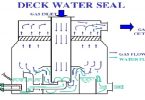Principle Of Operation
- Pressure vacuum relief valves have weight-loaded or spring-loaded pallets. Flow through the valve is controlled by the weight of the pallet or the spring force acting on the pallet to keep the device closed.
- Once the pressure or vacuum in the tank reaches the pallet closing force, the pallet will start to lift off the seat and allow flow through the valve.
- Due to its air-cushioned sealing technology, valves prevent emission losses until very close to the set pressure, and prevents air intake until very close to the set vacuum.
- The geometry of the valves has been developed in order to optimise overall performance in terms of high flow capacity, set pressure, sealing and re-sealing.
- The modular nature of valves means they can be tailored to meet specific customer requirements: whether this is pressure or vacuum-protection only; or vapours and gases either piped-away or vented to atmosphere.
- A weather hood protects the pressure vent port and a mesh screen is fitted to prevent intrusion of foreign matter into the valve
Precautions regarding high-velocity valves.
A pressure vacuum (PV) valve is designed to release and/or let in pressure to protect the cargo tank from exploding or imploding due to too high or too low pressure in the tank. See picture of PV-valve on previous page. The PV-valve must be looked after due to the possibility that they may be clogged from freezing vapours, polymer build-up or icing up in adverse weather conditions, always be sure that the PV-valve is working before commence loading/discharging.



how to set the alarm settings of pressure vaccum valve, how it works?
test the PV valves at what value must be pressurised the cargo tank?